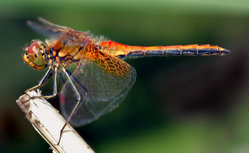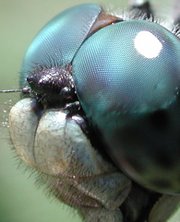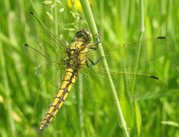Dragonfly
A dragonfly (also known as devil's darning needle) is an insect belonging to the order Odonata, the suborder Epiprocta and, in the strict sense, the infraorder Anisoptera. more...
It is characterized by large multifaceted eyes, two pairs of strong transparent wings, and an elongated body. Conventionally, the Anisoptera were given suborder rank beside the "ancient dragonflies" (Anisozygoptera, 2 living species and numerous fossil ones), but it has been determined recently that the Anisozygoptera form a paraphyletic assemblage of primitive relatives of the Anisoptera. Thus, the Anisoptera are reduced to an infraorder, forming the new suborder Epiprocta (dragonflies in a general sense). The artificial grouping Anisozygoptera is disbanded, its members being recognized as largely extinct offshoots at various stages of dragonfly evolution.
Dragonflies typically eat mosquitoes, midges and other small insects like flies, bees, and butterflies. They are usually found around lakes, ponds, streams, and wetlands because their larvae, known as "nymphs", are aquatic. Dragonflies do not bite or sting humans. In fact, they are valued as a predator that helps control the populations of insects that do, such as mosquitoes.
General facts
The life cycle of the dragonfly, from egg to death of adult, varies from six months to as much as six or seven years. Female dragonflies lay eggs in or near water, often in or on floating or emergent plants. Most of the life cycle is spent in the larval (nymph) form, beneath the water surface, using internal gills to breathe, and catching other invertebrates or even vertebrates such as tadpoles and fish.
In the adult (flying) stage, larger species of dragonfly can live as long as four months. Dragonflies have very good eyesight due to their unique eye structure. Dragonflies have up to 30,000 facets to their eyes; each one is a separate light-sensing organ or ommatidium, arranged to give nearly a 360° field of vision.
Much larger dragonfly species existed in the distant past than occur on earth today. The largest, found as a fossil, is an extinct Protodonata named Meganeura monyi from the Permian period with a wingspan of 70–75 cm (27.5–29.5 in). This compares to 19 cm (7.5 in) for the largest modern species of odonates, the Hawaiian endemic dragonfly, Anax strenuus. The smallest modern species recorded is the libellulid dragonfly, Nannophya pygmaea from east Asia with a wing span of only 20 mm, or about 3/4 of an inch.
The Common Green Darner dragonfly (Anax junius) is nicknamed "Darning Needle" because of its body shape. It is one of the biggest and fastest-flying dragonflies, able to reach speeds of 85 km/h (53 mph).
Damselflies (Suborder Zygoptera) are often confused with dragonflies, but the two insects are distinct: damselflies at rest hold their wings together above the body, whereas dragonflies at rest hold them out, either horizontally or slightly down and forward. Also, the eyes on a damselfly are separated, while those of the dragonfly are nearly touching. Both are members of the Odonata, and their life cycles are similar.
It was recently discovered that dragonflies employ a particular optical illusion, termed motion camouflage, to stalk other insects which invade their territory. A dragonfly can move in such a way as to project itself as a stationary object while speedily attacking its victims, new research suggests. These findings illustrate for the first time how dragonflies use complex camouflaging techniques during aerial combat.
Dragonflies are the world's fastest insects, capable of reaching speeds of up to 60 mph.
Some common species
- Emperor, Anax imperator
- Keeled Skimmer, Orthetrum coerulescens
- Black-tailed Skimmer, Orthetrum cancellatum
- Common Whitetail, Libellula lydia
- Migrant Hawker, Aeshna mixta
- Azure Hawker Aeshna caerulea
- Southern Hawker, Aeshna cyanea
- Norfolk Hawker, Aeshna isoceles
- Common Hawker, Aeshna juncea
- Red-veined Darter, Sympetrum fonscolombii
- Common Darter , Sympetrum striolatum
- Vagrant Darter, Sympetrum vulgatum
- Yellow-winged Darter, Sympetrum flaveolum
- Broad-bodied Chaser , Libellula depressa
- Four-spotted Chaser , Libellula quadrimaculata
- Scarce Chaser, Libellula fulva
- Green Darner, Anax junius
- Downy Emerald, Cordulia aenea
Footnotes
- ^ Noted physicist Richard Feynman chased dragonflies around a pool once to prove to his friends that, while dragonflies evoke a particular kind of terror in some humans, they are in fact completely harmless.
Sources
- Lohmann, H. 1996. Das phylogenetische System der Anisoptera (Odonata). Entomologische Zeitschrift 106:209-266.
- Rehn, A.C. 2003. Phylogenetic analysis of higher-level relationships of Odonata. Systematic Entomology 28:181-240.
- Silsby, Jill. 2001. Dragonflies of the World. Smithsonian Institution Press, Washington D.C. ISBN 1560989599
- Insect behaviour: Motion camouflage in dragonflies.. Nature. 2003 Jun 5;423(6940):604.
Read more at Wikipedia.org




